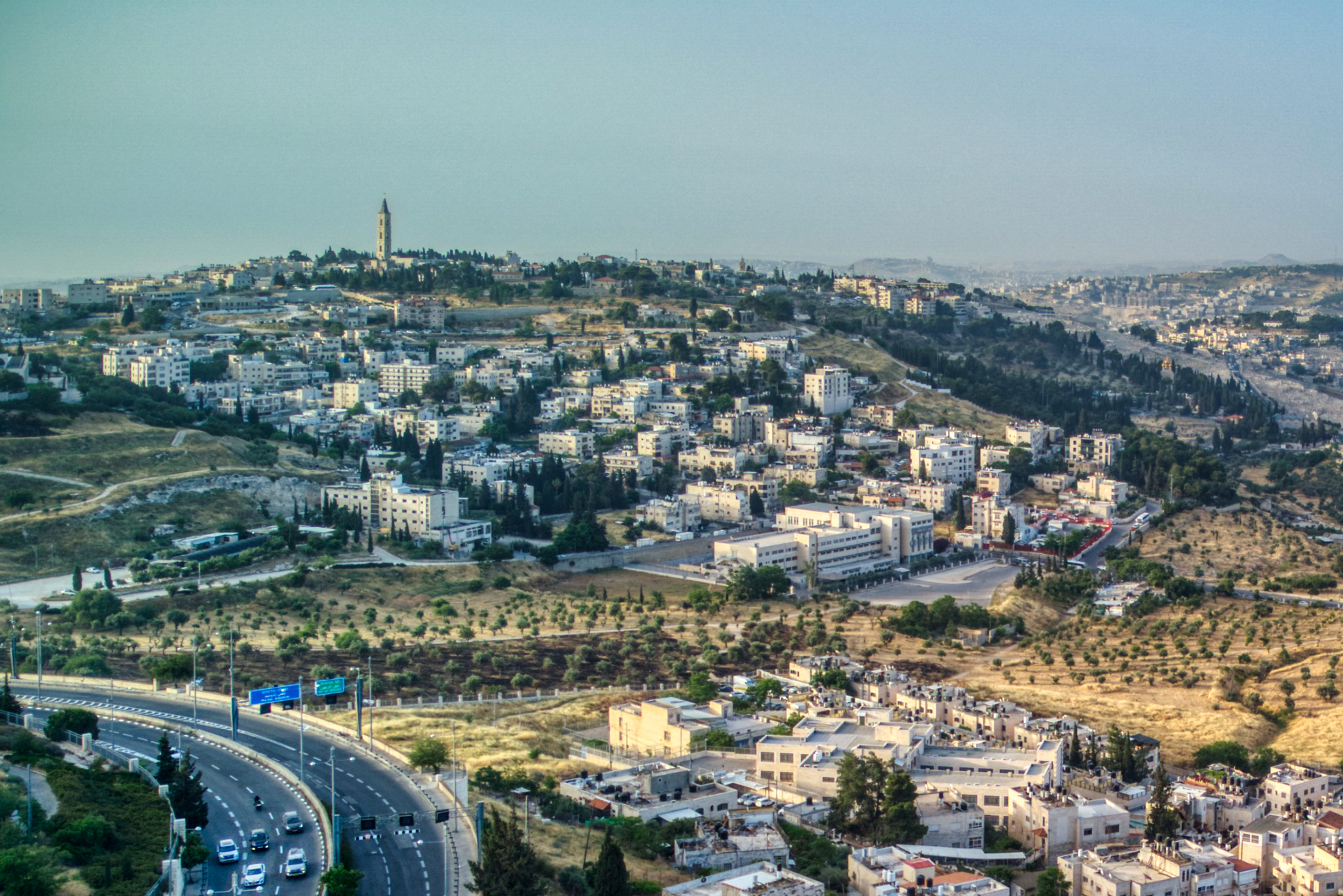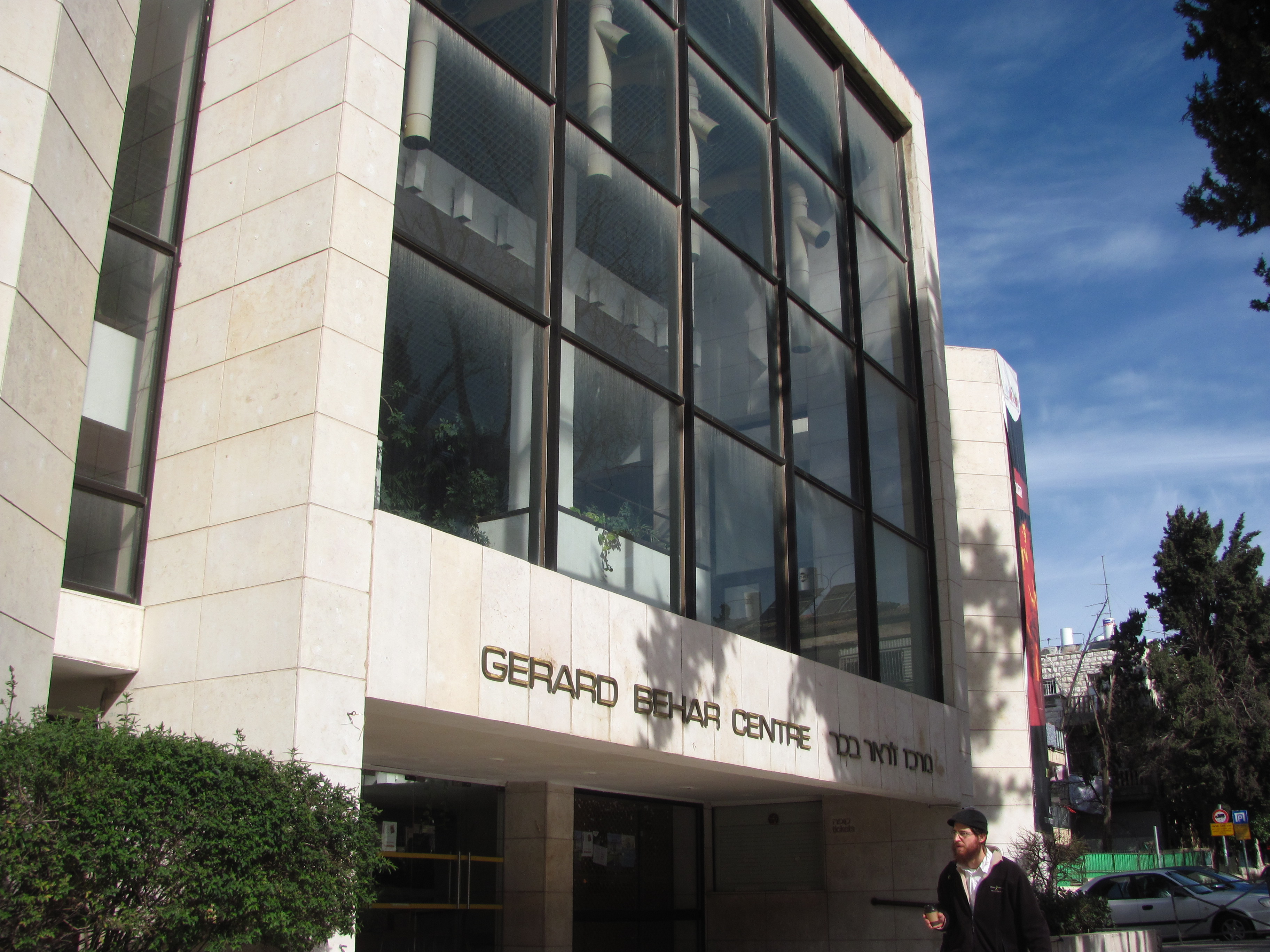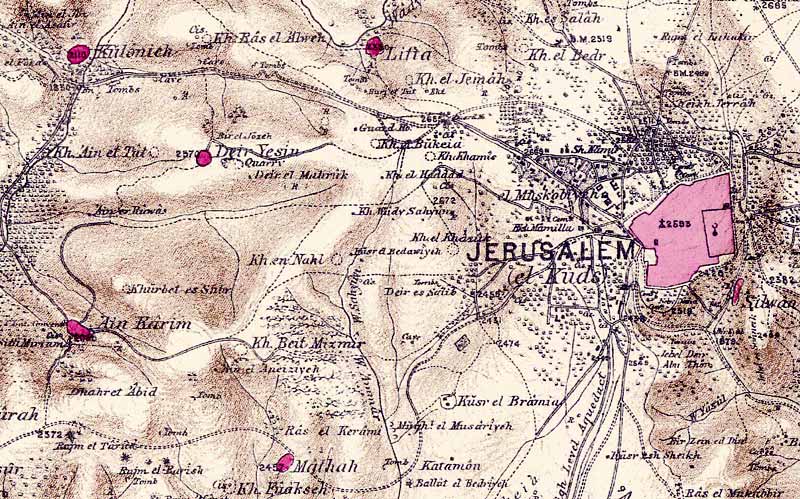|
Sheikh Badr, Jerusalem
Sheikh Badr ( ; ) was a Palestinian Arab village on a hilltop in west Jerusalem. The Haganah expelled its population during the 1947–1948 Civil War in Mandatory Palestine.Morris, 2004, p121/ref> From 1948 to 1951, Sheikh Badr Cemetery, a temporary Jewish cemetery was established here; a few hundred graves still remain from that time. After 1949, the area was incorporated into a new area called Givat Ram. Location Sheikh Badr was on a hilltop south of Jaffa Road, extending from the present-day Hebrew University of Jerusalem at Givat Ram to the Jerusalem International Convention Center (Binyanei HaUma). Its western flank was bordered to the north by the Jewish neighborhood of Romema,Khalidi, 1992, p. 303 founded in 1921, placing it close to the entrance to the city of Jerusalem. The site is now occupied by the International Convention Center and the Crowne Plaza Hotel. History Antiquity Archaeological excavations indicate that the area of Sheikh Badr was inhabited from Iron A ... [...More Info...] [...Related Items...] OR: [Wikipedia] [Google] [Baidu] |
Mandatory Palestine
Mandatory Palestine was a British Empire, British geopolitical entity that existed between 1920 and 1948 in the Palestine (region), region of Palestine, and after 1922, under the terms of the League of Nations's Mandate for Palestine. After an Arab Revolt, Arab uprising against the Ottoman Empire during the First World War in 1916, British Empire, British Egyptian Expeditionary Force, forces drove Ottoman Empire, Ottoman forces out of the Levant. The United Kingdom had agreed in the McMahon–Hussein Correspondence that it would honour Arab independence in case of a revolt but, in the end, the United Kingdom and French Third Republic, France divided what had been Ottoman Syria under the Sykes–Picot Agreement—an act of betrayal in the eyes of the Arabs. Another issue was the Balfour Declaration of 1917, in which Britain promised its support for the establishment of a Homeland for the Jewish people, Jewish "national home" in Palestine. Mandatory Palestine was then establishe ... [...More Info...] [...Related Items...] OR: [Wikipedia] [Google] [Baidu] |
Byzantine
The Byzantine Empire, also known as the Eastern Roman Empire, was the continuation of the Roman Empire centred on Constantinople during late antiquity and the Middle Ages. Having survived the events that caused the fall of the Western Roman Empire in the 5th centuryAD, it endured until the fall of Constantinople to the Ottoman Empire in 1453. The term 'Byzantine Empire' was coined only after its demise; its citizens used the term 'Roman Empire' and called themselves 'Romans'. During the early centuries of the Roman Empire, the western provinces were Latinised, but the eastern parts kept their Hellenistic culture. Constantine I () legalised Christianity and moved the capital to Constantinople. Theodosius I () made Christianity the state religion and Greek gradually replaced Latin for official use. The empire adopted a defensive strategy and, throughout its remaining history, experienced recurring cycles of decline and recovery. It reached its greatest extent un ... [...More Info...] [...Related Items...] OR: [Wikipedia] [Google] [Baidu] |
The Jerusalem Post
''The Jerusalem Post'' is an English language, English-language Israeli broadsheet newspaper based in Jerusalem, Israel, founded in 1932 during the Mandate for Palestine, British Mandate of Mandatory Palestine, Palestine by Gershon Agron as ''The Palestine Post''. In 1950, it changed its name to ''The Jerusalem Post''. In 2004, the paper was bought by Mirkaei Tikshoret, a diversified Israeli media firm controlled by investor Eli Azur (who in 2014 also acquired the newspaper ''Maariv (newspaper), Maariv''). ''The Jerusalem Post'' is published in English. Previously, it also had a French edition. The paper describes itself as being in the Politics of Israel, Israeli political political center, center, which is considered to be Centre-right politics, center-right by Far-right politics in Israel, international standards; its editorial line is critical of political corruption, and supportive of the separation of religion and state in Israel. It is also a strong proponent of greater in ... [...More Info...] [...Related Items...] OR: [Wikipedia] [Google] [Baidu] |
Battle For Jerusalem (1948)
The Battle for Jerusalem took place during the 1947–1948 civil war phase of the 1947–1949 Palestine war. It saw Jewish and Arab militias in Mandatory Palestine, and later the militaries of Israel and Transjordan, fight for control over the city of Jerusalem. Under the 1947 United Nations Partition Plan for Palestine, Jerusalem was to be a ''corpus separatum'' () administered by an international body. Fighting nevertheless immediately broke out in the city between Jewish and Arab militias, with bombings and other attacks being carried out by both sides. Beginning in February 1948, Arab militias under Abd al-Qadir al-Husayni blockaded the corridor from Tel Aviv to Jerusalem, preventing essential supplies from reaching the Jewish population. This blockade was broken in mid-April of that year by Jewish militias who carried out Operation Nachshon and Operation Maccabi. On 14 May and the following days, the Etzioni and Harel brigades, supported by Irgun troops, launche ... [...More Info...] [...Related Items...] OR: [Wikipedia] [Google] [Baidu] |
Mount Of Olives
The Mount of Olives or Mount Olivet (; ; both lit. 'Mount of Olives'; in Arabic also , , 'the Mountain') is a mountain ridge in East Jerusalem, east of and adjacent to Old City of Jerusalem, Jerusalem's Old City. It is named for the olive, olive groves that once covered its slopes. The southern part of the mount was the Silwan necropolis, attributed to the elite of the ancient Kingdom of Judah. The western slopes of the mount, those facing Jerusalem, have been used as a Mount of Olives Jewish Cemetery, Jewish cemetery for over 3,000 years and holds approximately 150,000 graves, making it central in the tradition of Jewish cemetery, Jewish cemeteries. Atop the hill lies the State of Palestine, Palestinian neighbourhood of At-Tur (Mount of Olives), At-Tur, a former village that is now part of East Jerusalem. Several key events in the life of Jesus, as related in the Gospels, took place on the Mount of Olives, and in the Acts of the Apostles it is described as the place from which J ... [...More Info...] [...Related Items...] OR: [Wikipedia] [Google] [Baidu] |
Sb Cemetery 2
SB or Sb may refer to: Places United States *San Bernardino, California, a city * Santa Barbara, California, a city * South Burlington, Vermont, a city Elsewhere * Saint Pierre and Miquelon, a territory of France (FIPS PUB 10-4 territory code SB) * Solomon Islands, a country (ISO 3166 country code SB) * Sibiu County, a county in Romania Organisations * Special Branch, of UK and some Commonwealth police * Służba Bezpieczeństwa, secret police in communist Poland * Sluzhba Bezpeky, WWII Ukrainian partisan underground intelligence service * Shaw Brothers Studio, a Hong Kong movie company * Statistics Bureau (Japan) * Šiaulių bankas, a Lithuanian commercial bank * Sarvajana Balaya, Sri Lankan political alliance Science and technology * SB buffer, for electrophoresis * Antimony, symbol Sb, a chemical element * Barred spiral galaxy, in astronomy * Scientiæ Baccalaureus or Bachelor of Science, an academic degree * Spectroscopic binary stars, designated SB1 and SB2 * Stilb (u ... [...More Info...] [...Related Items...] OR: [Wikipedia] [Google] [Baidu] |
Nahlaot
Nachlaot (, also ''Naḥlaʾoth'') is a cluster of 32 neigbourhoods, many of them courtyard neighborhoods in central Jerusalem surrounding the Mahane Yehuda Market. It is known for its narrow, winding lanes, old-style housing, hidden courtyards and many small synagogues. Neighborhoods in Nachlaot (plural of ''nachala'', lit. "homestead") include Batei Broide (founded 1902), Batei Goral (founded 1885), Batei Minsk (1895), Batei Munkacs (1931), Batei Rand (1908), Batei Ya'akovson (1902), Bet Ya'acov (1877), Even Yisrael (1875, the oldest of the group), Knesset Yisrael (three neighbourhoods: Knesset A, B and C and founded in 1891, 1903 and 1925 respectively), Mahane Yehuda (1888), Mazkeret Moshe (1882), Mishkenot Yisrael (1876), Nachalat Achim (1892), Nahalat Yaakov (1927), Nahalat Zion (1891), Neve Bezalel (1924), Neve Shalom (1896), Ohel Moshe (1883), Ohel Shlomo (1891), Shaare Rahamim (1906), Shaare Zedek (1889), Sha'arei Yerushalayim (1891), Shevet Achim (18 ... [...More Info...] [...Related Items...] OR: [Wikipedia] [Google] [Baidu] |
Salim Tamari
Salim Tamari (; born 1945), is a Palestinian sociologist who is the director of the Institute of Palestine Studies and an adjunct professor at the Center for Contemporary Arab Studies at Georgetown University. Rashid Khalidi, the Edward Said Professor of Modern Arab Studies at Columbia University, has called Tamari "the preeminent Palestinian historical sociologist." Early life and education Tamari was born in Jaffa, British Mandate Palestine, in 1945. When he was three years old, in April 1948, his family fled Jaffa when it was attacked by Jewish paramilitary groups as part of the 1948 Arab–Israeli War. Tamari studied at Birzeit College (later renamed Birzeit University) in the West Bank and then received a B.A. in politics from Drew University in New Jersey, United States. He later received an M.A. in sociology from the University of New Hampshire and a Ph.D. in sociology from the University of Manchester. Career Tamari has been a sociologist at Birzeit University since 197 ... [...More Info...] [...Related Items...] OR: [Wikipedia] [Google] [Baidu] |
Mukhtar
A mukhtar (; ) is a village chief in the Levant: "an old institution that goes back to the time of the Ottoman rule". According to Amir S. Cheshin, Bill Hutman and Avi Melamed, the mukhtar "for centuries were the central figures". They "were not restricted to Muslim communities"; even "Christian and Jewish communities in the Arab world also had mukhtars." Mukhtars are headmen or clan elders. They traditionally linked villagers with the state bureaucracy. Some of the mukhtar’s duties included registering life events (births, marriages, etc.) and notarizing documents. Quoting Tore Björgo: "The mukhtar was, among other things, responsible for collecting taxes and ensuring that law and order was prevailing in his village". Gaza British rulers in Palestine before Israel's establishment in 1948 depended on mukhtars to rule. In Gaza, there are still dozens of families that function as powerful clans. These families derive their influence from overseeing businesses and have the ... [...More Info...] [...Related Items...] OR: [Wikipedia] [Google] [Baidu] |
Lehi (group)
Lehi (; , sometimes abbreviated "LHI"), officially the Fighters for the Freedom of Israel () and often known pejoratively as the Stern Gang,"This group was known to its friends as LEHI and to its enemies as the Stern Gang." Blumberg, Arnold. ''History of Israel'', Westport, CT: Greenwood Publishing Group, Incorporated, 1998. p 106."calling themselves Lohamei Herut Yisrael (LHI) or, less generously, the Stern Gang." Lozowick, Yaacov. ''Right to Exist : A Moral Defense of Israel's Wars''. Westminster, MD: Doubleday Publishing, 2003. p. 78."''It ended in a split with Stern leading his own group out of the Irgun. This was known pejoratively by the British as "the Stern Gang' – later as Lehi''" Shindler, Colin. ''Triumph of Military Zionism : Nationalism and the Origins of the Israeli Right''. London, GBR: I.B. Tauris & Company, Ltd., 2005. p. 218."''Known by their Hebrew acronym as LEHI they were more familiar, not to say notorious, to the rest of the world as the Stern Gang – a ... [...More Info...] [...Related Items...] OR: [Wikipedia] [Google] [Baidu] |
Lifta
Lifta (; ) was a Palestinian village on the outskirts of Jerusalem. The village's Palestinian Arab inhabitants were expelled by Zionist paramilitary forces during the 1948 Palestine war. During the Ottoman period, the village was recorded to have a population of 400 Arabs, all Muslim households. In 1834, a battle took place in the village during the Palestinian Peasants' Revolt. A British 1922 census registered Lifta's population at 1,451, all Muslims. Prior to 1948, the village had orchards, several olive presses, a winepress, in addition to a modern clinic, two coffeehouses, two carpentry shops, barbershops, a butcher, and a mosque. In the 1945 statistics the population of Lifta was 2,250; 2,230 Muslims and 20 Christians. In addition, a small number of Jews resided in the village, and one former Jewish inhabitant described the relationship her family and the Palestinian Arab majority as 'excellent'. During the 1948 Palestine war, a massacre occurred on 28 December 194 ... [...More Info...] [...Related Items...] OR: [Wikipedia] [Google] [Baidu] |
Sacher Park
Sacher Park (Hebrew: גן סאקר) is the largest public park in the center of Jerusalem,עריית ירושלים: גן סאקר Jerusalem Municipality: Gan Sacher . Retrieved on July 24, 2011. near the neighborhoods of Kiryat Wolfson and and adjoins the Israel Government Complex. The park was created in 1963, and named after [...More Info...] [...Related Items...] OR: [Wikipedia] [Google] [Baidu] |






